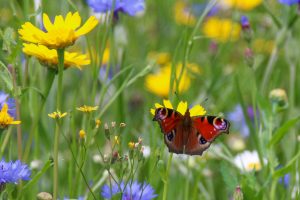 1. Choose your area
1. Choose your area
The first step to creating your wild meadow is to select an area of your garden for it to occupy. It needs to be an open space in a sunny position, but can be on flat or sloping ground. You may choose an area of your lawn, or an unused flower bed or border. The plant seeds can be planted into the soil or an established grass area.
2. Reduce fertility
Highly fertile soil encourages excess vigour in grasses causing them to crowd out wildflowers, so if your soil has been enriched with fertiliser, it may be too rich for growing a perennial wild meadow. You can reduce the fertility of the soil by removing 3-6 inches of topsoil using a turf cutter or spade, or plant a crop of mustard plants as these will absorb a lot of nutrients. If you are planting your wildflowers on an existing lawn, stop using fertiliser and weed killer beforehand. This step can be skipped if you are planting an annual wildflower meadow.
3. Prepare the soil
If you are sowing in soil, making sure to prepare the ground beforehand. Rake the soil to a fine tilth , then lay some black plastic sheeting over it so any existing weeds in the soil germinate then die. If your soil contains stronger perennial weeds such as docks, nettles, and dandelions, you may need to weed these out. You can then water if necessary. If you are planting on a lawn, mow the lawn to less than 5cm long before sowing wildflowers.
4. Sow the seeds
Now time for the fun part- sowing the seeds! There are some great wildflower seed mixtures out there, which offer a ready-made diverse meadow. They can offer a colourful variety of native flowers, specifically selected to attract bees, butterflies, and other beneficial pollinators into your garden. If you prefer, you can also choose your own selection of flowers. You might include ox-eye daisies, red clover, cowslip, and field scabious. The most useful addition is the yellow rattle, which has the magic ability to reduce the vigour of grasses as well as eyebright and lousewort.
You will need about 5 grams of seed per square metre of meadow. Scatter the seeds as you walk across the ground; there is no need to cover with soil, but gently walk across the seeds afterwards, or roll the area, to make sure they are in contact with the soil. If you are converting a lawn into a meadow you could try using wildflower plug plants. Keep growing plants well-watered until they are established, and protect from birds and slugs.
5. Maintenance
In the first year of growth, cut your wild meadow in July-August. In subsequent years, cut it from September onwards once the summer is over, and perhaps again in early spring. You might use a strimmer or power scythe for a large area, or a scythe or shears for smaller areas. Leave the cut hay on the patch for a week so the seeds can drop, then clear away and compost to prevent the soil from becoming too rich.
You may need to do some weeding to remove dock, nettles and thistles. It is a good idea to water annual wildflowers while they establish. Perennial meadows should be left to grow naturally without any additional water.
Your meadow will continue to evolve year by year; some may take years to establish properly and flower, with some species overtaking others over time. You may wish to add more flowers as you go along, especially if you choose annual species which die after one blooming season. Wildflower meadows will attract bees and butterflies- you may also see bats, birds, grasshoppers, and other wildlife.